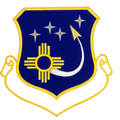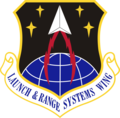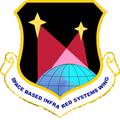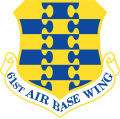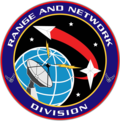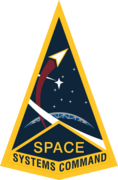Space Systems Command
| Space Systems Command | |
|---|---|
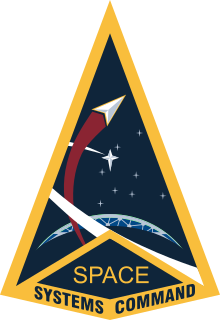 Space Systems Command emblem | |
| Founded | 13 August 2021 (3 years, 4 months) as Space Systems Command Established on 20 Mar 1961 and organized on 1 Apr 1961 |
| Country | |
| Branch | |
| Type | Field command |
| Role | |
| Size | 10,000 personnel[2] |
| Headquarters | Los Angeles Air Force Base, California, U.S. |
| Colors | Gold[3] |
| Decorations | Air Force Organization Excellence Award[4] |
| Website | ssc.spaceforce.mil |
| Commanders | |
| Commander | |
| Deputy Commander | Col Michele K. Idle |
| Senior Enlisted Leader | CMSgt Jacqueline Sauvé[5] |
| Insignia | |
| Flag | |
Space Systems Command (SSC) is the United States Space Force's space development, acquisition, launch, and logistics field command. It is headquartered at Los Angeles Air Force Base, California, and manages the United States' space launch ranges.[6]
The Western Development Division (WDD) was established on 1 April 1954 under Air Research and Development Command to manage the U.S. Air Force's ballistic missile program. It assumed responsibility for spacecraft development in 1955 and was renamed the Air Force Ballistic Missile Division (AFBMD) in 1957. As part of Air Research and Development Command's transformation, the Air Force Ballistic Missile Division's space and missile responsibilities were split. As such, the Space Systems Division (SSD) was established on 20 Mar 1961 and organized (activated) on 1 Apr 1961. In 1967, the Space Systems Division was reorganized as the Space and Missile Systems Organization (SAMSO), absorbing the Ballistic Systems Division's mission. In 1979, the Space and Missile Systems Organization was renamed the Space Division and divested itself of ballistic missile development. In 1989, the Space Division returned to its historic name of the Space Systems Division and regained its ballistic missile development role in 1990.
With the merger of Air Force Systems Command and Air Force Logistics Command in 1992, the Space Systems Division was redesignated the Space and Missile Systems Center (SMC). In response to the recommendations of the Space Commission, in 2001 it was reassigned to Air Force Space Command, remaining attached through its redesignation as Space Operations Command in October 2020. On 22 April 2021, it transferred from a U.S. Air Force unit to a U.S. Space Force unit and was reassigned from Space Operations Command to Headquarters United States Space Force. On 13 August 2021, the Space and Missile Systems Center was renamed Space Systems Command and became a full U.S. Space Force field command.[7][4]
History
The Military Space Program begins under Air Research and Development Command

Western Development Division
The United States' ballistic missile program was started by the United States Army Air Forces immediately after the end of the Second World War, with the German Army's employment of the V-2 rocket demonstrating its viability. However, initial efforts to combine ballistic missiles and nuclear weapons was technologically infeasible until the development of thermonuclear weapons. In the early 1950s, the Soviet Union was outpacing the United States in ballistic missile development, leading Trevor Gardner to charter the Teapot Committee to determine why the United States was struggling.[8]
As a direct result of the Committee's recommendation, Air Research and Development Command established the Western Development Division at Los Angeles Air Force Station under Brigadier General Bernard Schriever on 1 July 1954 to manage the Air Force's ballistic missile program. The Western Development Division's first program was the Convair SM-65 Atlas intercontinental ballistic missile, however by 1955 it initiated development of the Martin HGM-25A Titan I ICBM and Douglas PGM-17 Thor intermediate range ballistic missile. On 10 October 1955, the Western Development Division gained responsibility for spacecraft development when the Weapon System 117L satellite, intended to conduct reconnaissance and missile warning, was transferred from the Wright Air Development Center. On 1 June 1957, the Western Development Division was renamed the Air Force Ballistic Missile Division.[8]
Air Force Ballistic Missile Division

On 20 September 1957, the Air Force Ballistic Missile Division conducted the first launch of a Thor missile from Cape Canaveral Air Force Station, Florida and on 17 December 1957, also performed the first launch of an Atlas missile. By 1960, the PGM-17 Thor IRBM was deployed to the United Kingdom and turned over to Strategic Air Command and the Royal Air Force. The SM-65 Atlas ICBM was turned over SAC by the end of 1962. In 1960, the HGM-25A Titan I ICBM made its first flight and was turned over to Strategic Air Command in 1962, completing the deployment of the first-generation ballistic missiles.[8]
These first-generation ballistic missiles also served as the foundation for the first-generation of space launch vehicles. The first space launch vehicle developed by the Air Force Ballistic Missile Division was the Thor-Able, which used a Thor IRBM as the first stage and a Vanguard-derived Able. Its first launch was on 11 October 1958. The first satellite launched by the Air Force Ballistic Missile Division was the Army Signal Corps SCORE using an Atlas B. The Thor and Atlas rocket families would form the core of the United States' space launch fleet. Following its 1958 establishment, NASA immediately began using the Thor for space launches and in 1959 developed the Thor-Delta. The Atlas was adopted by NASA in 1959 and Project Mercury used the Atlas LV-3B for its orbital flights, with the Army's Mercury-Redstone Launch Vehicle used only for sub-orbital flights.[8]
Following the launch of Sputnik 1 by the Soviet Union, the Eisenhower administration attempted to centralize all military and civil space programs in the Advanced Research Projects Agency, however responsibility was returned to the military services in September 1959. The U.S. Army was designated as the lead service for communication satellites, the U.S. Navy for navigation satellites, and the U.S. Air Force for reconnaissance and surveillance satellites and space launch vehicles. This split arrangement lasted until March 1961, when Secretary of Defense Robert McNamara assigned the Air Force a near monopoly on military space development, with the exception of reconnaissance programs, which were passed to the National Reconnaissance Office in 1961.[8]
The Weapon System 117L program, initially intending to perform a variety of task under different sub-systems, was broken into three different programs in 1959. The Discoverer Program, better known as Corona, was a photographic reconnaissance satellite that ejected film for recovery in-atmosphere. The Discoverers were launched using a Thor-Agena booster, with Discoverer 1 becoming the first satellite to enter a polar orbit and Discoverer 2 was the first to have three-axis stabilization. In 1960, Discoverer 13 was the first to return a capsule when it crashed into the Pacific Ocean and Discoverer 14 marked the first successful return of film when it was recovered in-air by a 6593d Test Squadron Fairchild JC-119 Flying Boxcar.[8] The Satellite and Missile Observation Program (SAMOS), was intended as a heavier counterpart to Discoverer and used the Atlas-Agena booster. SAMOS was intended to collect photographic and electromagnetic reconnaissance data, but instead of returning film capsules to earth, SAMOS would electronically transmit the data to ground stations. However, the technology for electro-optical film readout was not mature and it was canceled by Undersecretary of the Air Force Joseph V. Charyk. The Missile Defense Alarm System (MIDAS) was the third program derived from WS 117L and focused on providing missile warning of ICBMs using infrared sensors. Initial plans called for a constellation of eight spacecraft in polar orbits to monitor the Soviet Union, however due to early satellite failures it remained a test program until 1968.[8]
To control these satellites, in 1958 the Air Force Ballistic Missile Division established an interim satellite control facility at Lockheed Missile and Space Division. On 6 April 1959, the 6594th Test Wing was established to operate the facility and on 1 March 1960 it transferred operations to Sunnyvale Air Force Station in California. It also established a global Air Force Satellite Control Network. On 1 November 1959, the 6592nd Support Group was established to manage Los Angeles Air Force Station.[8]
The first space missions launched by the Air Force Ballistic Missile Division were not military, the but scientific Pioneer lunar probes. First directed by the Advanced Research Projects Agency, they were later turned over to NASA. The Thor-Able rocket was specifically developed by the Air Force Ballistic Missile Agency for these lunar missions, which aimed to enhance scientific knowledge and American global prestige during the Cold War. ARPA assigned the Air Force Ballistic Missile Division responsibility for three probes to be launched with the Thor-Able, the Army Ballistic Missile Agency two probes to be launched with the Juno II, and the Naval Ordnance Test Station to provide the imaging system. Pioneer 0, Pioneer 1, and Pioneer 2 were the Air Force Ballistic Missile Division's lunar probes. While Pioneer 0 and Pioneer 2 suffered launch failures and Pioneer 1 only traveled a third of the way to the Moon, it was world's first deep space probe and provided information on the extent of the Van Allen radiation belts.[8]
Space and missile development under Air Force Systems Command

Space Systems Division
On 1 April 1961, Air Research and Development Command was reorganized as Air Force Systems Command. Space and missile programs had grown to the point where the Air Force Ballistic Missile Division was split on 1 April 1961, with space systems being organized under the Space Systems Division and missile programs under the Ballistic Systems Division.[4]
The Ballistic Systems Division, which moved to Norton Air Force Base, continued the work of the Air Force Ballistic Missile Division on second-generation ballistic missiles. The first major missile system it worked on was the LGM-25C Titan II ICBM, which was an improvement over the LGM-25A Titan I. It featured storable propellent, an all-inertial guidance system, and could be launched from undergrounds missile silos. The first Titan IIs came on alert with Strategic Air Command in June 1963. It also began development of the LGM-30 Minuteman ICBM, which was the first Air Force ballistic missile to use solid fuel rather than liquid fuel. The first Minuteman I was launched by the Air Force Ballistic Missile Division on 1 February 1962 and turned over to Strategic Air Command on 11 September 1962. By 1965, the Minuteman I had replaced the Atlas and Titan I ICBMs.[8]
The Space Systems Division, still located at Los Angeles Air Force Station, carried on the Air Force Ballistic Missile Division's development of the Titan III space launch vehicle, which was initiated in 1961 and first flow on 1 September 1964. The Titan IIIA consisted of a modified Titan II ballistic missile with a Transtage upper stage. The Titan IIIC was first launched from Cape Canaveral Space Force Station on 18 June 1965 and used two large solid rocket booster. The Space Systems Division also developed the Titan IIIB and provided NASA with Titan II GLVs for Project Gemini and developed the Agena target vehicle.[8]
In 1963, the Space Systems Division initiated the Defense Support Program, which was intended to succeed where MIDAS failed and create an orbital constellation of infrared missile warning sensors. It also continued developing the Vela nuclear detonation detection satellites. The Vela satellite network came out of an Air Force Ballistic Missile Division–Atomic Energy Commission–NASA agreement in 1960 to develop a high-altitude nuclear detection system to ensure compliance with the Partial Nuclear Test Ban Treaty. The Atomic Energy Commission flew test detectors on Space Systems Division Discoverer satellites and the first Vela satellites were launched on an Atlas-Agena on 16 October 1963.[8]
The Space Systems Division also began development on the Defense Meteorological Support Program (DMSP). The DMSP Block 1 satellites were launched on a Scout X-2 rocket in 1962, however the other four launch attempts failed. Further DMSP Block I launches were conducted on the Thor-Agena and Thor-Burner boosters. The Thor-Burner also launched the DMSP Block II and DMSP Block III satellites, which provided weather reconnaissance during the Vietnam War. The Block 4 satellites first launched in 1966. The Army Signal Corps' project SCORE, launched by the Air Force Ballistic Missile Division in 1958, was the world's first communications satellite but intended as a proof of concept. The Army Signal Corps followed by launching Courier 1B on an Air Force Ballistic Missile Division Thor-Ablestar in 1960, but it failed after 17 days in orbit. The Space Systems Division began development on the Initial Defense Communications Satellite Program (IDCSP) in 1962, launching constellations from 1966 to 1968. the IDCSP, also known as the Defense Satellite Communications Program Phase I (DSCS I) once operational, transmitted both voice and images to support the United States during the Vietnam War.[8]
Although almost all crewed spacecraft programs went to NASA after its creation in 1958, the Air Force retained the Boeing X-20 Dyna-Soar program under the Wright Air Development Center, with the Titan IIIC initially intended as its booster. The program, however, was canceled in 1963 when it was determined that the Blue Gemini program would better satisfy its objectives. However, Defense Secretary Robert McNamara announced the Manned Orbiting Laboratory program, which was assigned to the Space Systems Division by General Bernard Schriever. Douglas Aircraft Company was responsible for the spacecraft, and the Space Systems Division was developing the Titan IIIM booster. However, the program only had a single test flight, OPS 0855, before being canceled in 1969.[8]
The Space Systems Division also was responsible for anti-satellite weapons development. The first United States ASAT system was the Army's Nike Zeus missiles located at Kwajalein Missile Range and declared operational in 1963, but shut down in 1964 by the Defense Department, which favored the Air Force's ASAT efforts. The Space Systems Division's Program 437 used Thor boosters and nuclear warheads to destroy a satellite or space-based weapon from Johnston Atoll. The system was declared operational in 1964 and turned over to Aerospace Defense Command, however it was put on standby in 1970 and shut down in 1975. Program 437 also include the Program 437AP configuration, which give it the capability to inspect satellites. The Space Systems Division also managed the Space Test Program, known as the Space Experiments Support Program until 1971, for the Defense Department since it began in 1965.[8]
In 1965, Space Systems Division replaced the 6594th Aerospace Test Wing with the Air Force Satellite Control Facility. Space launches were also conducted by the Space Systems Division, with the 6595th Aerospace Test Wing responsible for Vandenberg Air Force Base launches and the 6555th Aerospace Test Wing responsible for launches from Cape Canaveral Air Force Station.[8]
Space and Missile Systems Organization


-
Space and Missile Test Center
-
6592d Support Group
On 1 July 1967, the Space Systems Division and Ballistic Systems Division were remerged, forming the Space and Missile Systems Office (SAMSO).[4] This remerger was prompted by economic reasons and SAMSO was located as Los Angeles Air Force Station. SAMSO did not start any new ballistic missile programs, but did oversee the replacement of the Minuteman I with the Minuteman II, which had improved range and guidance, and the Minuteman III, which more penetration aids to counter anti-ballistic missile defense systems and could be equipped with three multiple independently targetable reentry vehicles.[8]
The Titan III space launch vehicle family was also expanded to include the Titan IIID and Titan IIIE, which were used to support NASA's launch of the Viking program in 1976. The Space and Missile Systems Organization was also the Department of Defense lead for the Space Transportation System, which would be developed into the Space Shuttle. As part of its contribution, it built a Space Shuttle launch and recovery site at Vandenberg Air Force Base for polar launches and also developed the Inertial Upper Stage.[8]
The Space and Missile Systems Organization also oversaw the first launch of the Defense Support Program in 1970 on a Titan IIIC and the development and launch of the Advanced Vela satellites on Titan IIICs in 1967, 1969, and 1970. Three Defense Meteorological Support Program Block 5A, Block 5B, Block 5C, and Block 5D-1 satellites were also launched in the 1970s.[8]
Although not an Air Force program, the Navy's Transit satellite system was the world's first satellite navigation constellation and started development in 1958. It was first launched on an Air Force Ballistic Missile Division booster in 1960 and achieved initial operational capability in 1964 and full operational capability in 1968. Transit used three operational satellites to enable users on ships and submarines to calculate their location in two dimensions and continued to operate until 1996. The Navy and Air Force both began follow on programs, with the Space and Missile Systems Organization developing Project 621B, envisioning a constellation of 20 satellites in synchronous inclined orbits. The Navy's Timation program instead envisioned a constellation of 21 to 27 satellites in medium altitude orbits. In 1973, Deputy Secretary of Defense William P. Clements directed the two programs merge into the Space and Missile Systems Organization's Global Positioning System, which used Program 621B's signal structure and frequencies and the medium earth orbits of Timation.[8]
The Space and Missile Systems Organization also led the development of the Defense Satellite Communications System Phase II (DSCS II). DSCS II had increased communications capacity, greater transmission strength, and longer lifetimes. As well, they also had steerable antennas. The first developmental contract was issued in 1969 and the first launch to geosynchronous orbit occurred in 1971, with the full constellation being formed in 1979. SAMSO also operationalized the Lincoln Experimental Satellites and Tactical Communications Satellite, building the Fleet Satellite Communications System (FLTSATCOM). Although the FLTSATCOM program was owned by the Navy, SAMSO managed the satellite acquisition, which started in 1971. It also managed the Air Force Satellite Communications system which became operational in 1978 and relied on transponders on FLTSATCOM and enabled the Air Force control over its strategic forces. SAMSO also managed the acquisition and launch of Skynet 1, which was launched on behalf of the Royal Air Force in 1969 and 1970. SAMSO also assisted the United Kingdom with the development of Skynet 2, which launched in 1974 and was turned over to the Royal Air Force in 1975. SAMSO also acquired and launched the NATO II and NATO III satellites. DSCS II, Skynet, and the NATO satellites were designed to be compatible with each other.[8]
During the 1970s, the Space and Missile Systems Organization began a follow-on ASAT program to Program 437 that did not use nuclear warheads. The first, Project Spike, used a two-staged missile launched from a Convair F-106 Delta Dart. Project Spike did not enter development, however it served as a proof of concept for the Air-launched ASAT, which entered development in 1976.[8]
In 1970, SAMSO's 6555th Aerospace Test Wing at Cape Canaveral Air Force Station became the 6555th Aerospace Test Group and realigned under its 6595th Aerospace Test Wing at Vandenberg Air Force Base. The 6595th Aerospace Test Wing was then realigned under SAMSO's new Space and Missile Test Center (SAMTEC), which oversaw launches at both Vandenberg Air Force Base and Cape Canaveral Space Force Station and operated the Western Test Range. In 1977, it gained the Eastern Test Range. On 1 August 1971, the 6592nd Support Group for Los Angeles Air Force Station was redesignated the 6592nd Air Base Group.[8]
Space Division
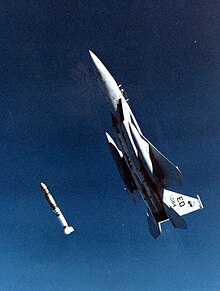
-
Space and Missile Test Organization
-
Air Force Geophysics Laboratory
-
Ballistic Systems Organization
-
6592nd Air Base Group
On 1 October 1979, the Space and Missile Systems Organization was redesignated as the Space Division and split off its ballistic missile functions into the Ballistic Missile Office due to growth in both mission areas.[4]
Starting in 1982, the Ballistic Missile Office assisted Strategic Air Command in deactivating the remaining Titan II missiles and placing them into storage for possible conversion into space launch vehicles. Under the Strategic Arms Limitation Talks, both the United States and Soviet Union were limited in the number of missiles they could deploy. This shifted the focus to quality. In 1973, the Space and Missile Systems Organization started the MX program, which looked at traditionally silo-based, ground-mobile, and air-launched ballistic missile options. In 1982, it was named the LGM-118 Peacekeeper ICBM by President Ronald Reagan and was capable of launching ten reentry vehicles at different targets more than 6,000 miles away. In 1983, the Peacekeeper had its first test launch from Vandenberg Air Force Base to a target in the Kwajalein Missile Range and the first went on alert with Strategic Air Command in 1986, being fully deployed in 1988. The permanent basing construct including making the Peacekeeper rail-mobile on trains, but with the end of the Cold War those plans were canceled by President George H. W. Bush in 1991. The Ballistic Missile Office also started development on the MGM-134 Midgetman ICBM in 1986, also known as the Small ICBM, which would be held in road-mobile launchers. Its first test flight occurred in 1991 from Vandenberg Air Force Base to a target in the Kwajalein Missile Range, but was canceled in 1992 due to the end of the Cold War.[8]
The Space Division continued the Space and Missile Systems Organization's military development of the Space Shuttle alongside NASA, however in 1986 the Space Shuttle Challenger exploded during launch, forcing NASA to suspend all launches until 1988. Not only did it suspend the development of Shuttle launch and recovery facilities at Vandenberg Air Force Base, but also delayed all military payloads that were scheduled to be launched on the shuttle. The Space Division had been developing the Titan 34D as a backup in the event that there were any issues with the Shuttle program and after two launch failures in 1985 and 1986 suspended Titan 34 Launches, they resumed in 1987, restoring the only launch alternative to the Space Shuttle for large payloads. The Titan IV had already started development in 1985, but the Challenger disaster reinforced the need to have a diverse fleet of space launch vehicles. The Titan IV had its first launch in 1989 and could use either the Inertial Upper Stage or an upgraded Centaur stage. It also began the development of two new medium launch vehicles, with the Delta II intended to launch the Global Positioning System and the Atlas II intended to launch the Defense Satellite Communications System.[8]

The Space Division launched the first Defense Meteorological Support Program Block 5D-2s and started the procurement process for DMSP Block 5D-3s, as well as starting the deployment of the Global Positioning System constellation. It also continued the Defense Satellite Communications System Phase III deployment, launching the first in 1982 and the full constellation was completed in 1993. The Military Strategic and Tactical Relay, or Milstar, strategic satellite communication program was started in 1982.[8]
The Space Division initiated the largest change to the Air Force Satellite Control Network since its inception, with Secretary of Defense Harold Brown authorizing the construction of a Consolidated Space Operations Center at Falcon Air Force Base in 1979. It was intended to comprise two parts, a Satellite Operations Complex to replace Onizuka Air Force Base and a Shuttle Operations and Planning Center to replace Johnson Space Center for military missions. The Shuttle Operation and Planning Center was canceled in 1987, while the Consolidated Space Operations Center gradually came online in 1989 and was fully transferred to Air Force Space Command in 1993.[8]
The Space Division also continued the air-launched ASAT program that SAMSO started in 1976, culminating in the development of the ASM-135 ASAT. Its first test was on 21 January 1984 and on 13 September 1985, it was launched from a McDonnell Douglas F-15A Eagle to destroy the Solwind research satellite. The program was terminated in 1988 due to budgetary and congressional restrictions. Starting in 1983, the Department of Defense announced the Strategic Defense Initiative to provide missile defense, with the Space Division responsible for its space-based and Air Force components. In 1987, the Strategic Defense Initiative Organization selected the Space Division's Boost Surveillance and Tracking System, Space Surveillance and Tracking System, and Space-Based Interceptor for demonstration.[8]
Immediately following the establishment of the Space Division on 1 October 1979, the Space and Missile Test Center was redesignated as the Space and Missile Test Organization, comprising the Eastern Space and Missile Center at Cape Canaveral Air Force Station and the Western Space and Missile Center at Vandenberg Air Force Base. On 1 September 1982, Air Force Space Command was activated as the Air Force's first major command for space and on 1 October 1987 the Air Force Satellite Control Facility was inactivated, with its functions being replaced by Air Force Space Command's wings. The Space and Missile Test Organization was inactivated on 1 October 1989, and on 1 October 1990 the Eastern Space and Missile Center and Western Space and Missile Center were transferred to Air Force Space Command's 9th Space Division, making it responsible for space launch.[8]
However, the Space Division did gain responsibility for some research and development functions, gaining the Air Force Space Technology Center at Kirtland Air Force Base in October 1982. The Air Force Space Technology Center consisted of the Air Force Weapons Laboratory, Air Force Geophysics Laboratory, and Air Force Rocket Propulsion Laboratory. In 1990, the Air Force Space Technology Center was renamed the Phillips Laboratory and its three sub-laboratories were directly incorporated into it.[8]
On 15 March 1989, the Space Division reassumed its historical name of the Space Systems Division and the Ballistic Missile Office also was renamed the Ballistic Systems Division. Due to cutbacks in the ballistic missile program due to the end of the Cold War, the Ballistic Systems Division was renamed the Ballistic Missile Organization and realigned under the Space Systems Division on 5 May 1990.[8][4]
Realignment under Air Force Space Command

-
Ballistic Systems Organization
-
655th Air Base Squadron

As part of the Air Force's restructuring in the early 1990s, Air Force Systems Command merged with Air Force Logistics Command to form Air Force Materiel Command on 1 July 1992. As part of this merger, the Space Systems Division was redesignated as the Space and Missile Systems Center on the same date.[4] On 1 October 1993, the 6592nd Air Base Group was redesignated the 655th Air Base Squadron as part of an Air Force-wide restructuring of support groups. In January 1993, Kirtland Air Force Base and the 377th Air Base Wing were directly assigned to the Space and Missile Systems Center and the 61st Air Base Group at Los Angeles Air Force Base was activated on 1 October 1994, replacing the 655th Air Base Squadron. On 8 April 1997, the Philips Laboratory was merged with other Air Force laboratories to form the Air Force Research Laboratory and Kirtland Air Force Base and its 377th Air Base Wing was transferred to the Air Armament Center on 1 October 1998. The remaining space functions at Kirtland AFB, including test and evaluation, launch of experimental payloads, and Space Shuttle Operations were consolidated into Detachment 12 which activated on 29 June 2001.[8]
The START I treaty of 1991 and START II treaty of 1993 between the United States and the Soviet Union and its successor, the Russian Federation, dramatically reduced the amount of nuclear warheads in each superpower's arsenal. This resulted in the U.S. Air Force reducing the amount of Minuteman missiles, reconfiguring its missiles to have only one warhead, and scrapping the Pershing missiles. Due to the dramatic reduction in ballistic missiles, the Space and Missile Systems Center's Ballistic Missile Organization was officially inactivated in September 1993.[8]
The Space and Missile Systems Center followed up on the Space Division's development of the Delta II and Atlas II space launch vehicles, procuring launches using the upgraded Atlas III, which used the Russian RD-180 engine. Following six launch failures from April 1998 to May 1999 the Department of Defense started the Launch Broad Area Review, releasing its report in November 1999 and recommending that the Space and Missile Systems Center have broadened responsibility for all Department of Defense launches, from acquisition to deliver of spacecraft on-orbit.[8]
In August 1994, President Bill Clinton signed a National Transportation Space Policy, assigning responsibility for expendable launch vehicles to the Defense Department and directed it to develop improved variants of current vehicles. In response, the Space and Missile Systems Center built the Evolved Expendable Launch Vehicle program and awarded the first contracts in 1995. One went to McDonnell Douglas for the Delta IV and Delta IV Heavy, while the other went to Lockheed Martin for the Atlas V.[8] In 2006, the two launch providers merged to form United Launch Alliance.[9] In 2016, SpaceX was awarded its first military launch under the Evolved Expendable Launch Vehicle program, using its Falcon 9 and Falcon Heavy boosters.[10][11] In 2019, in part due to SpaceX's success with reusable rockets, the program's name was changed to National Security Space Launch.[12]
In 1994, the Space and Missile Systems Center had started the Space-Based Infrared System (SBIRS) program to replace the Defense Support Program. SBIRS was built upon technology tested for the Strategic Defense Initiative, launching its first satellite in 2011.[13] Since the 1970s, proposals were made to merge the military and National Oceanic and Atmospheric Administration's (NOAA) weather satellites. In 1994, President Clinton directed that the programs eventually be merged. In 1995, the Air Force, NASA, and NOAA started the National Polar-orbiting Operational Environmental Satellite System which was intended to replace the Defense Metrological Support Program and be operated by NOAA, but the program collapsed due to cost overruns in 2010 and a full merging of the programs has not occurred. A second Defense Department-only effort, the Defense Weather Satellite System, was canceled by Congress in 2012.[14]
The Global Positioning System constellation became fully completed in 1994 and achieved initial operational capability in 1995. Milstar had its first launch in 1995 and the Space and Missile Systems Center started development on the Wideband Global SATCOM system to replace the Defense Satellite Communications System and the Advanced Extremely High Frequency to replace Milstar. The Brilliant Pebbles space-based anti-missile interceptor was transferred to the Space and Missile Systems Center in 1993 from the Ballistic Missile Defense Organization, but was terminated in 1994.[8]
In 2001, the Space Commission came out with its report on national security space. A major recommendation was realigning the Space and Missile Systems Center from Air Force Materiel Command to Air Force Space Command to consolidate management of space programs to one major command. This occurred on 1 October 2001.[8]
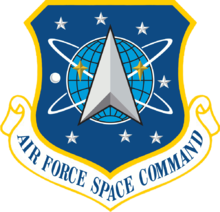
-
Satellite Control Network Systems Group
-
Space Logistics Group
-
Defense Meteorological Satellite Program Systems Group
-
Missile Defense Systems Group
On 1 August 2006, the Space and Missile Systems Center reorganized itself along a traditional Air Force wing and group construct. These included the Military Satellite Communications Systems Wing which replaced the MILSATCOM Joint System Program Office (JPO), the Launch and Range Systems Wing, which replaced the Launch and Ranges JPO, the Global Positioning Systems Wing, which replaced the Navstar GPS JPO, the Space-Based Infrared Systems Wing, which replaced the SBIRS System Program Office (SPO), the Space Superiority Systems Wing, the Space Development and Test Wing at Kirtland Air Force Base, which included the former SMC Detachment 12, the 61st Air Base Wing, which replaced the 61st Air Base Group, the Satellite Control and Network Systems Group, which replaced the Air Force Satellite Control Network SPO, the Space Logistics Group, which replaced the SMC Logistics Support Squadron, and the Defense Meteorological Satellite Program Systems Group, which replaced the DMSP SPO.[15] On 31 March 2008, the Missile Defense Systems Group was activated.[4]
-
Range and Network Systems Division
-
Space Logistics Directorate
However, in response to the lead of Air Force Materiel Command, on 10 November 2010 the wings and groups redesignated as directorates and divisions as part of an Air Force acquisitions wide effort.[16] This resulted in the 61st Air Base Wing being inactivated and replaced with the 61st Air Base Group, the GPS Wing becoming the Global Positioning Systems Directorate, the Launch and Range Systems Wing becoming the Launch Enterprise Directorate, the MILSATCOM Wing becoming the Military Satellite Communications Directorate, the Space Superiority Systems Wing becoming the Space Superiority Systems Directorate, the SIBRS Wing becoming the Infrared Space Systems Directorate, the Space Development and Test Wing becoming the Space Development and Test Directorate, the Space Logistics Group becoming the Space Logistics Directorate, the DMSP Group becoming the Defense Weather Systems Directorate, the Missile Defense Systems Group becoming the Missile Defense Systems Division, and the Satellite Control and Network Systems Group becoming the Satellite Control and Network Systems Division [17]
In 2014, the Space and Missile Systems Center combined its Developmental Planning Directorate and the Space Development and Test Directorate to form the Advanced Systems and Development Directorate.[18] The Range and Network Systems Division was eventually stood up to replace the functions of the Satellite Control and Network Systems Division and in 2015 the Defense Weather Systems Directorate and Infrared Space Systems Directorate were combined into the Remote Sensing Systems Directorate.[19][20] In 2019, these directorates were all replaced as part of the SMC 2.0 reorganization, which instead established the Development Corps, which was responsible for innovation and prototyping, a Production Corps, an Enterprise Corps, which conducted support for products and launch, and an Atlas Corps which provided personnel management.[21]
Redesignation as Space Systems Command and transfer to the Space Force

When the United States Space Force was established as an independent service on 20 December 2019, Air Force Space Command was redesignated as United States Space Force, but functionally remained a major command within the Air Force. The Space and Missile Systems Center remained a part of United States Space Force as it was redesignated as Space Operations Command, until it was reassigned to Headquarters Space Force on 22 April 2021 and officially transferred from the U.S. Air Force center to a U.S. Space Force field command, although it continued to use the Space and Missile Systems Center name.[4]
In July 2021, President Biden nominated Deputy Director of the National Reconnaissance Office Maj Gen Michael Guetlein to lead Space Systems Command. He was confirmed with a promotion to lieutenant general on 29 July 2021 which became effective on 13 August 2021.[22]
On 13 August 2021, the Space and Missile Systems Center was redesignated as Space Systems Command on 13 August 2021. The commander is a Space Force lieutenant general, while the deputy command is a Space Force major general and is also responsible for space launch. In addition to Space and Missile Systems Center units realigning, the 61st Air Base Group was redesignated the Los Angeles Garrison. Space Systems Command also gained Space Launch Delta 30 and Space Launch Delta 45, which they had given up to Air Force Space Command in 1990. The commander of Space Launch Delta 45, a brigadier general, is the Space Systems Command operations director and range acquisitions lead. Air Force Research Laboratory space units, such as the Space Vehicles Directorate, Space Electro-Optical Division, Rocket Propulsion Division, and Space Systems Technology Division, administratively report to Space Systems Command, while remaining under the aligned under Air Force Research Labs. The Air Force Life Cycle Management Center's Strategic Warning and Surveillance Systems Division, responsible for ground-based radars, missile warning, space domain awareness, missile defense systems, and shared early warning capabilities, transferred to Space Systems Command.[7] Space Systems Command also provides support to the Space Rapid Capabilities Office and Space Development Agency (to be transferred in 2022), which are direct reporting units to the Chief of Space Operations.[7]
Further developments
One 8 December 2023, SSC stood up the first two provisional System Deltas (SYDs) in an activation and assumption of command ceremony at the Los Angeles Air Force Base.
The two SYDs will prototype a new concept to maximize the recently announced provisional Integrated Mission Deltas (IMDs), which are organized around mission areas (e.g. position, navigation, and timing; electromagnetic warfare) instead of functional ones (e.g. intelligence, operations, cyber effects). The new Deltas were announced by the Chief of Space Operations Gen. Chance Saltzman in a CSO Notice To Guardians published 13 October 2023.[23]
SYDs will consolidate program offices in SSC that design, develop, and deliver mission systems under a mission-focused command structure for acquisitions. IMDs will consolidate all aspects of mission-area readiness into a single organization, combining units in Space Operations Command (SpOC) that perform mission generation, intelligence support, and cyber defense with program offices at SSC that handle sustainment.
Pairing IMDs in SpOC with complementary SYDs in SSC will streamline unity of effort for capability development.[24]
Symbolism
-
Space Systems Command (2021–present)
-
Space and Missile Systems Center (2002–2021)
-
Space and Missile Systems Center, Space Systems Division, Space Division, and Space and Missile Systems Organization (1968–2002)
-
Space and Missile Systems Organization (1967–1968)
-
Space Systems Division (1962–1967)
-
Ballistic Systems Division (1962–1967)
-
Space Systems Division and Ballistic Systems Division (1961–1962)
-
Air Force Ballistic Missile Division (1960–1961)
-
Western Development Division and Air Force Ballistic Missile Division (1954–1960)
Space Systems Command emblem and color
At the top of the design, rising into space, is a delta riding on an ignition plume. The delta and plume represent the launch vehicles need to place Space Force assets into orbit and signifies launch operations from West and East coast ranges. The constellation Aquila symbolizes the space environment, reflecting Space Systems Command's developing and fielding of space warfighting capabilities. The primary star represents the Space Force's on-orbit capabilities. The sweeping orbit and thunderbolt represent the Space Force's space assets safeguarding the Earth.[3]
Gold is Space Systems Command's distinguishing color and signifying the excellence and intelligence required to identify, prototype, and field innovative space capabilities.[3]
The Space Systems Command emblem and flag were unveiled on 13 April 2021, replacing the Space and Missile Systems Center emblem.[25]
Post–2002 Space and Missile Systems Center emblem
After space and missiles functions were reunited under the Space and Missile Systems Center, it continued to use the old Space and Missile Systems Organization emblem for 10 years. However, when the Space and Missile Systems Center transferred from Air Force Materiel Command to Air Force Space Command it adopted a new emblem on 2 August 2002 to better express its mission and allegiance to Air Force Space Command.[8]
Blue and yellow are the Air Force colors. Blue alludes to the sky, the primary theater of Air Force operations. Yellow refers to the sun and the excellence required of Air Force personnel. The globe represents the night and day missions that the satellite and missile systems must perform. The four pole stars symbolize the communication, navigation, surveillance and weather satellites utilized by the Center. The flight symbol stands for deployed missile systems.[8]
Pre–2002 Space and Missile Systems Center, Space Division, and Space and Missile Systems Organization emblem
When the Space and Missile Systems Organization was activated in 1967, it determined it needed a new emblem to represent its space and missile missions. The SAMSO emblem was first approved on 22 May 1968. When the Space Division was established in 1979, it continued to use the SAMSO emblem but reinterpreted it. When the Space and Missile Systems Center was established in 1992, the dual space and missile symbiology was restored. The emblem was replaced in 2002 when the Space and Missile Systems Center transferred to Air Force Space Command.[26]
The Space and Missile Systems Center Organizational emblem represents the cooperation of science, industry, and the military in advancing the defense technology of the United States, and the role of SMC in unifying and directing this effort. It also symbolizes the two major elements of the Organization's mission-- missile and space booster power and satellites in orbit.[27]
In the first symbolism, the diagonal lines represent the role of science, industry, and the military, respectively, in advancing defense technology; and the triangle depicts the function of SMC in directing and managing the work of these elements in the pursuit of desired military objectives. The circle surrounding the diagonal lines represents the total integrating role of SMC in planning, developing and testing military systems and in acquiring them for the national defense.[27]
In the second symbolism, the triangle joined by the three lines symbolizes rocket booster power for payloads as the basis for both ballistic missile and space systems, while the circle represents both satellites and their orbital traces.[27]
Air Force Ballistic Missile Division, Space Systems Division, and Ballistic Systems Division
When the Western Development Division was first established in 1954, it used the emblem of its major command, Air Research and Development Command. This was carried over by the Air Force Ballistic Missile Division until it created its own emblem on 2 November 1960, which was based on Air Research and Development Command's. However, with the activation of Air Force Systems Command in 1961, the Air Force Ballistic Missile Division was split.[8]
The Space Systems Division was established in 1961 and modified the Air Force Ballistic Missile Division's emblem to form its own, was used from 5 July 1962 until the Space and Missile Systems Organization was formed in 1967. The Ballistic Systems Division also modified elements of the Air Force Ballistic Missile Division, having its emblem approved on 14 February 1962. The Ballistic Systems Division's emblem was retired following the Space and Missile Systems Organization's establishment in 1967, but the Ballistic Missile Office received authorization to use it starting on 1 December 1980, and it was continuously used by the Ballistic Systems Division and Ballistic Missile Organization until it was inactivated on 2 September 1993.[8]
Structure
| Delta | Headquarters | Current commander |
|---|---|---|
| Space Systems Command | ||
| Los Angeles Air Force Base, California | Col Mia L. Walsh | |
| Peterson Space Force Base, Colorado | ||
| Los Angeles Air Force Base, California | Col Chad W. Melone | |
| Los Angeles Air Force Base, California | Col James T. Horne[31] | |
| Vandenberg Space Force Base, California | Col Mark A. Shoemaker | |
| Patrick Space Force Base, Florida | Brig Gen Kristin Panzenhagen | |
| Los Angeles Air Force Base, California | Col Cecilia Montes de Oca[32] | |
| Los Angeles Air Force Base, California | Col Peter C. Mastro | |
| Peterson Space Force Base, Colorado | Shawn Sawyer | |
| Los Angeles Air Force Base, California | Charlotte M. Gerhart | |
| Los Angeles Air Force Base, California | Col A. J. Ashby[32] | |
| Naval Base Point Loma, California[34] | Capt Peter J. Sheehy | |
| Los Angeles Air Force Base, California | Matthew L. Spencer | |
| Washington, D.C. | Col Richard Kniseley[32] | |
| Los Angeles Air Force Base, California | Col Heather B. Bogstie | |
| Los Angeles Air Force Base, California | Col Daniel J. Visosky[32] | |
| Los Angeles Air Force Base, California | Col Daniel T. Walter | |
| Peterson Space Force Base, Colorado | Anita J. McCorvey | |
| Kirtland Air Force Base, New Mexico | Col Joseph J. Roth | |
| Los Angeles Air Force Base, California | Col Corey J. Klopstein | |
| Los Angeles Air Force Base, California | Col Erik S. Stockham | |
| Los Angeles Air Force Base, California | John Kirkemo | |
| Peterson Space Force Base, Colorado | F. Schnell | |
| Peterson Space Force Base, Colorado | Col Jason E. West | |
| Los Angeles Air Force Base, California | Jordan Riedel | |
Denotes planned unit but not yet activated.
List of commanders

| No. | Commander | Term | |||
|---|---|---|---|---|---|
| Portrait | Name | Took office | Left office | Duration | |
| 1 | Lieutenant General Michael Guetlein | 13 August 2021 | 21 December 2023 | 2 years, 130 days | |
| - | Joy M. White Acting | 21 December 2023 | 1 February 2024 | 42 days | |
| 2 | Lieutenant General Philip Garrant | 1 February 2024 | Incumbent | 345 days | |
See also
U.S. Armed Forces systems commands
- Army Materiel Command
- Marine Corps Systems Command
- United States Navy systems commands
- Air Force Materiel Command
References
- ^ "About Space Systems Command".
- ^ "USSF establishes 2nd Field Command, Guetlein assumes command". 13 August 2021.
- ^ a b c "SSC Emblem Final Reveal".
- ^ a b c d e f g h i "Space Systems Command (USSF) Lineage". Retrieved 31 January 2022.
- ^ "Chief Master Sergeant Jacqueline Sauvé". spaceforce.mil.
- ^ "Now boarding: Space Force wants to turn launch ranges into rocket 'airports'". 3 June 2021.
- ^ a b c "Space Force establishes Space Systems Command". 13 August 2021.
- ^ a b c d e f g h i j k l m n o p q r s t u v w x y z aa ab ac ad ae af ag ah ai aj ak al am an ao "Historical Overview of the Space and Missile Systems Center, 1954-2003" (PDF). Retrieved 31 January 2022.
- ^ "About ULA".
- ^ "SpaceX wins its first satellite launch for the US Air Force". 27 April 2016.
- ^ "Air Force certified Falcon Heavy for national security launch but more work needed to meet required orbits". 21 September 2019.
- ^ "EELV isn't what it used to be: Air Force changes launch program name". 4 March 2019.
- ^ "45th Space Wing Launches First SBIRS GEO Satellite". 13 May 2011.
- ^ "Space Force moves closer to replacing aging DMSP weather sats". 22 December 2021.
- ^ "SMC Wing activation ceremony designates new organizations". 8 September 2006.
- ^ "Improvement plan realigns acquisition wings as directorates, some AFMC changes". 9 October 2009.
- ^ "SMC Redesignates Wings and Groups". 16 November 2010.
- ^ "SMC stands up new Advanced Systems and Development Directorate". 24 November 2014.
- ^ "Space and Missile Systems Center".
- ^ "US Air Force Opens Remote Sensing Systems Directorate - Via Satellite -". 22 April 2015.
- ^ "Air Force just months away from completing SMC 2.0 reorganization". 21 March 2019.
- ^ Strout, Nathan (14 July 2021). "Biden nominates deputy director of the National Reconnaissance Office to lead new Space Systems Command". Defense News. Retrieved 17 July 2021.
- ^ Saltzman, Chance (13 October 2023). "CSO NOTICE TO GUARDIANS (C-NOTE #18)" (PDF). Retrieved 7 February 2024.
- ^ a b c "SSC Launches Space Force's first two System Deltas". Defense Visual Information Distribution Service. Archived from the original on 9 December 2023. Retrieved 9 December 2023.
- ^ "End of an era: Space and Missile Systems Center is now Space Systems Command". 13 August 2021.
- ^ "Los Angeles Air Force Base > Home". Archived from the original on 20 September 2001.
- ^ a b c "Los Angeles Air Force Base > Home". Archived from the original on 26 September 2001.
- ^ "Contracts for January 25, 2022". U.S. Department of Defense. Archived from the original on 14 July 2022. Retrieved 14 July 2022.
- ^ "MilsatMagazine". Archived from the original on 25 June 2022. Retrieved 26 June 2022.
- ^ a b c d e f "Space Systems Command Org Chart - Nov 2022" (PDF). Archived (PDF) from the original on 7 April 2023. Retrieved 26 April 2023.
- ^ "Jim Horne - Patrick AFB, Florida, United States | Professional Profile | LinkedIn".
- ^ a b c d "Space Systems Command Organization" (PDF). spaceforce.mil. 31 July 2023. Archived (PDF) from the original on 24 October 2023. Retrieved 15 October 2023.
- ^ a b c d "Military Communications & Positioning, Navigation, and Timing Overview with GPS Update - PNT Advisory Board" (PDF). Archived (PDF) from the original on 5 December 2022. Retrieved 17 November 2022.
- ^ "Where We Operate". Archived from the original on 29 August 2022. Retrieved 29 August 2022.
- ^ Hitchens, Theresa (12 July 2022). "Space Force considers asking satellite firms to host payloads for tactical ISR". Archived from the original on 17 December 2023. Retrieved 14 July 2022.
- ^ "New Missile-Warning Satellite, Set to Launch, Will Complete SBIRS Constellation". 2 August 2022. Archived from the original on 4 August 2022. Retrieved 4 August 2022.
- ^ "MilsatMagazine". Archived from the original on 20 May 2022. Retrieved 26 June 2022.
Sources
![]() This article incorporates public domain material from the United States Government
This article incorporates public domain material from the United States Government














